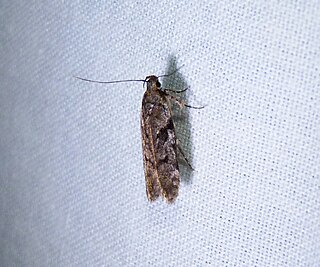
Pseudotelphusa is a genus of moths in the family Gelechiidae.

Pseudotelphusa scalella is a moth of the family Gelechiidae. It is found from most of Europe to the southern Ural and the Volga region. It is also found in Turkey.

Pseudotelphusa quercinigracella is a moth of the family Gelechiidae. It is found in the United States, including Kentucky, Maryland and Oklahoma.

Pseudotelphusa paripunctella is a moth of the family Gelechiidae. It is found from most of Europe to Siberia and the Caucasus.

Pseudotelphusa tessella is a moth of the family Gelechiidae. It is found in Spain, France, Germany, Austria, Switzerland, the Czech Republic, Slovakia, Slovenia, Serbia and Romania.

Pseudotelphusa istrella is a moth of the family Gelechiidae. It is found in Turkey, Italy, Slovakia, Croatia, Bosnia and Herzegovina, Romania, North Macedonia, Greece and Ukraine.
Pseudotelphusa trinephela is a moth of the family Gelechiidae. It is found in Zimbabwe.
Pseudotelphusa tornimacula is a moth of the family Gelechiidae. It is found in Zimbabwe and South Africa.
Pseudotelphusa paracycota is a moth of the family Gelechiidae. It is found in Zimbabwe and South Africa.
Pseudotelphusa griseotincta is a moth of the family Gelechiidae. It is found in South Africa.
Pseudotelphusa albopasta is a moth of the family Gelechiidae. It is found in South Africa.
Pseudotelphusa albisignata is a moth of the family Gelechiidae. It is found in South Africa.
Pseudotelphusa acrobrunella is a moth of the family Gelechiidae. It is found in Korea, Japan and the Russian Far East.
Pseudotelphusa amelanchierella is a moth of the family Gelechiidae. It is found in North America, where it has been recorded from Ohio.
Pseudotelphusa basifasciella is a moth of the family Gelechiidae. It is found in North America, where it has been recorded from Alabama, Arkansas, Georgia, Illinois, Indiana, Kentucky, Louisiana, Maine, Mississippi, New Hampshire, New York, North Carolina, Oklahoma, South Carolina, Tennessee and Texas.
Pseudotelphusa confixa is a moth of the family Gelechiidae first described by Edward Meyrick in 1918. It is found in South Africa.
Pseudotelphusa probata is a moth of the family Gelechiidae first described by Edward Meyrick in 1909. It is found in Gauteng, South Africa.
Pseudotelphusa incana is a moth of the family Gelechiidae. It is found in North America, where it has been recorded from New York.
Pseudotelphusa occidentella is a moth of the family Gelechiidae. It is found in southern France, Spain, Portugal and Morocco.
Pseudotelphusa sokolovae is a moth of the family Gelechiidae. It is found in Tajikistan.



